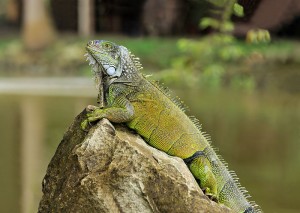
A wild female green iguana
Iguana iguana
Native range Central and South America and parts of the Caribbean
Invasive range Puerto Rico, US Virgin Islands, Florida, Texas, and Hawaii
Habitat Arboreal, often found near water.
Impacts Green iguanas compete with native lizards on islands in the Caribbean. They prey on the vulnerable Florida burrowing owl, and could affect tree snails with limited distributions. They are a potential hazard on airport runways in Puerto Rico.
Description With short legs and a long body that can reach up to 6 feet, iguanas are covered in short leathery scales. The tapered tail can be used as a weapon and for balance when climbing trees. Primarily herbivorous, an iguana’s spines are effective in defending against predation.
These days, a cold snap in Miami means a night when it rains iguanas. Down from sea grapes and buttonwood trees large, green, tree-dwelling invaders fall––because they’re native to warmer, more equatorial Central and South America. And there the lizards lie until the sun warms them up enough to move. It’s called “brumation,” the reptilian form of mammalian hibernation.

Blame the iguana invasion on the pet trade. The cute little salad-eaters with docile personalities make an easy sell. But then they grow up––to 6 feet long. They escape. Or they’re let loose by owners who can’t cope. They graze at the salad bar of the suburbs: shrubs, trees, orchids, figs, mangos, berries, tomatoes. They poop in or around water; a backyard swimming pool is perfect. They run into other iguanas in town. They breed. Their nest-burrowing digs up yards and undermines sidewalks, sea walls, and building foundations. They lay eggs––well, like reptiles, often in great numbers.

The Miami blue butterfly
That the green iguana is a herbivore is bad news for the endangered Miami Blue struggling to recolonize the Florida Keys: invading iguanas, having developed a taste for the nickerbean leaves where the blues lay their eggs, threaten to drive the butterfly into extinction.
If there is good news, it comes from Docteur André Nègre, author of The French West-Indies Through Their Cookery. Iguanas “feed themselves only on young vegetal shoots and on hibiscus flowers: no edible animal can boast of such a delicate food; man himself, if compared to this animal, eats filthy food, comparatively speaking.” R.P. Labat, in his Nouveaux Voyages aux Isles d’Amérique, 1722, reported that “The lizard’s flesh has the same whiteness, tenderness, exquisite taste and delicacy as the chicken’s.”* In Florida, the domestic dog, the burrowing owl, and the raccoon concur as to its tastiness. It seems that only Anthony Bourdain disagrees.
What’s more, by papal decree long ago, the cold-blooded iguana, fond of warm coastal waters, can be eaten on Friday and during Lent.
They are probably too well established in Florida to be eradicated, but they can be controlled and excluded on a local scale. Read more about one man’s efforts to rid Florida of the related spiny-tailed black iguana and Ctenosaur tacos at the South Beach Bar and Grille here.
University of Florida Extension’s profile of the iguana.
*As it turns out, iguanas may be healthier than chicken, too. They contain 24% protein compared to 18% in chicken.
Recipes
To prepare an iguana for cooking
Iguanas can be cleaned and skinned like a chicken, using the same best practices, since iguanas do carry salmonella.
Remove the head, organs, and entrails.
If you don’t want to skin it, dip it in hot water, then scrape the scales off, as you do with fish.
Parboil in salted water for 20 to 30 minutes before roasting or stewing.
Rafael, of Pomuch, Mexico, explains how here.
Iguana Pozole
Pozole is a traditional hominy stew of Mexico.
Adapted from Gabriel Martinez Campos in Wikibooks.
2 medium iguanas
5 cups of freshly bleached hominy
10 cloves of garlic
1 onion
1 slice of cabbage, diced
bay leaf
Mexican oregano
salt and pepper
Butcher skin and cut the iguana in pieces. Wash, salt and blanch for 15 to 20 minutes.
Simmer the corn, garlic, onion, a bay leaf, and salt to taste.
At 10 minutes add the meat. Cook for another 15 to 20 minutes.
Serve with sliced cabbage, onion slices, cilantro, oregano, and pepper to taste.
Night of the Iguana
One fellow’s take on preparing iguana: if it tastes just like chicken, why not wings?



























{ 2 comments… read them below or add one }
It would be great if you could provide a map of where iguanas are invasive.
We don’t have a map on hand, but green iguanas have become established in Puerto Rico, the US Virgin Islands, Florida, Texas, and Hawaii. They are also present on several islands in the Caribbean, including Martinique, Cayman Islands, and Turks and Caicos.